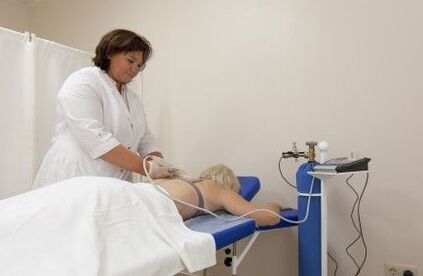Cervical spinal osteochondrosis is a relatively common disease, in which dystrophic changes occur in cartilagin tissue, in the disc between the vertebra and the base of the bone in it. This pathology develops in many people who have reached the age of 30. Symptoms for cervical osteochondrosis are varied, so it is difficult to diagnose the disease and choose the right treatment.

Factors that cause the appearance of disease
Cervical osteochondrosis can develop under the influence of the following factors:
- excess weight;
- work, inactive;
- Previous injury from the spinal column;
- mental disorders, nerve overstrain, stress;
- poor physical training;
- spinal curvature, scoliosis, improper posture;
- wrong body position, which has become a habit;
- tension in the neck, return during operation;
- tendency to genetic levels;
- unusual for the body of physical stress, increased activity;
- Inal food.
The spinal cervical area is subject to increased load, in which the cervical muscles try to lead to balance during the above source influence. This causes the appearance of muscle cramps, where there is a violation of blood transport throughout the body. As a result, the formation of anatomical damage is observed.
Osteochondrosis degree
In the process of developing cervical osteochondrosis, the disc between the vertebrae is weak, due to the structure of the disc, the vertebra, the articular fabric of the cervical region. The first degree disease continues almost symptoms, as changes in the new cartilage begin. In this case, one complains about the appearance:
- headache;
- discomfort in the neck, arms, shoulders;
- small restrictions in neck motor activity;
- short decline in visual function;
- Reduces sensitivity in the collar zone.
The second stage is sometimes accompanied by the appearance of small vertebral hernia, as well as narrowing the cracks between the vertebrae. Due to the violation of the nerve receptor, there is a point of pain in the process of movement. Against the background of the second degree disease, the patient recorded the appearance:
- Neck pain syndrome, digging with head movements;
- loss of skin sensitivity in the arm and shoulder area;
- reduction in visual function;
- rings in the ear;
- numbness in the face and neck;
- weakness in hand;
- shooting pain into the shoulder blade;
- Disruption in sleep function.

It is very difficult to treat the cervical area osteochondrosis in the third stage. Currently, the hernia develops, the spinal column of the defect, the change in position, the dislocation in the elements of the ridge is observed. The level of the disease is accompanied by:
- Pain spoken on the neck, myocardium, collar area;
- lack of skin sensitivity in the head, arms and shoulders;
- hand paralyzed;
- lack of tendon reflex;
- The formation of hernia in the cervical vertebra.
In the fourth (final) process, a sign of signs were observed.
Symptom
Signs of the disease in the neck are very different from the symptoms of osteochondrosis in other areas of the vertebral column.Because the cervical vertebra is located near, the nerve root and spinal cord are pinched.This leads to the appearance of these signs:
- The pain syndrome is located in the neck, nape, shoulders, arms and legs. At the time of the nerve receptor, the appearance of uncomfortable sensations in the shoulder zone, back of the head, hands began to rebuild. Due to cramps in the cervical muscles, blood circulation is disrupted.
- The incidence of weakness in the upper part is recorded, which is associated with damage to the root function, which contributes to the entry of the motor nerve that rebuild the muscle tissue in the hands.
- The upper limbs are rebuilt due to a decrease in sensitivity in it, a violation of the root in which the sensitive nerve endings are located.
- When turning on the head, a painful sensation appears, you can also hear the problem. This is explained by damage to the small joints of the cervical region, a decrease in the level of the intervertebral disc.
- Patients complain of insufficient strength, appearance of fatigue, dizziness, coordination disorders. Due to the displacement of the spinal cord, the vertebral artery is squeezed. As a result, blood circulation is worsening, leading to weakness of blood supply to the occipital and cerebellum.
- The appearance of problems with vision, loss of sensitivity in language is observed.
Symptoms for cervical osteochondrosis in women are no different from signs in men. Women who have reached the age of 45 and above, diagnosed with such a disease, numbness and tingling in the upper limbs in a dream.
What is the dangers of osteochondrosis of the cervical area
The disease can harm the body as a whole. At the neck is located in a significant artery, nerve receptors, blood vessels in which the brain is supplied. If a little disease occurs, they are squeezed.This causes the appearance of problems in blood supply to the brain.As a result, migraine formation, heart rhythm disorders, the appearance of problems with respiratory and visual functions are observed, coordination and attention are also affected.
Against the background of the neck osteochondrosis, the formation of the disease may be:
- pathology in the brain;
- Arterial vessels in the spine;
- spinal stroke.
The worst complication is the death of the patient, which can occur when squeezing the spinal cord. The symptoms and treatment of cervical osteochondrosis are caused by the level of the disease.
Therapeutic action for cervical osteochondrosis
Therapy for cervical spinal osteochondrosis is prescribed, regardless of the sexual sex of the patient. Treatment takes place at several stages:
- Removes painful manifestations.
- Swelling removal.
- Circulation of blood to the norm.
- Improve muscles in the back, press stomach, chest.
- Improves nutritional quality and regenerating tissue spine.
If the signs of an unimportant disease are found, you should consult a specialist. With such pathologies, integrated approaches are used, surgeons, neuropathologists, physiotherapists, and manual therapists are required.
For therapeutic purposes, against the background of cervical osteochondrosis, medicines, physiotherapy treatment, collar zone massage, and physiotherapy training are used, as they are quite effective in this situation.
Medicine
When detecting neck osteochondrosis, they are prescribed:
- preparation to eliminate muscle cramps;
- vitamins to improve the metabolic processes in the central nervous system;
- Medicines from NSAID groups to reduce pain, eliminate inflammation and swelling;
- Joints for joints, contributing to the recovery of cartilage, eliminating disruption in the disc between the vertebrae.
- Profitable medicines to improve the nutrition of impaired nerve tissue, the regulation of blood flow to the brain.
First aid to aggravate cervical osteochondrosis
Sometimes, if the pain syndrome becomes unbearable, but it is not possible to visit a doctor, experts advise taking analgesics. To ease the pain, you can use the "pepper patch" help, but this tool brings relief for only a short time.Patch will help heat the affected area and relieve pain for a while.To get rid of swelling, the use of herbal infusion is recommended for 3-4 days.
But it should be considered that it will not work to recover from cervical osteochondrosis using the method. This method helps to overcome the symptoms of the disease for a short time. To prescribe full therapy, you need to contact a specialist help.
Physiotherapy procedure
As part of complex treatments, to improve the effect, use:
- Electrophoresis - Analgesic drug ions are penetrated to affected areas due to electrical current effects. During the procedure, novocaine or lidocaine is commonly used.
- Laser therapy - it has anti -inflammatory effects, improves blood circulation through light.
- Magnetic therapy - helps to get rid of edema in tissues, has analgesic effects.
- Ultrasound - helps improve metabolism, anesthesia, eliminates inflammation in the affected area.

Physical Education Medicine
Also, with cervical osteochondrosis, therapeutic training will help improve well -being. Keep in mind that training performance cannot be accompanied by pain or discomfort. Training Complex:
- We lie on the stomach and rest on the floor. The back should be, and the head and body are raised. We took a long time in this position for about 2 minutes, so we returned to the starting position. We do a repetition of 2-3.
- We drowned to the floor, lying on your back, out of your hands all over the body. We turn our heads first to the right and then to the right, trying to touch the floor with the ear. We do 6-7 times training in each direction.
- We sit on the floor. We took a deep breath and tilted your head forward in an effort to touch her chest. In breathing, we remove your head back. Exercises must be repeated 10-15 times.
- We sit on the floor, press our hands on the forehead and at the same time we lower your head. This exercise must be done for about 30 seconds, repeatedly 2-3 times.
- Slowly, slowly, we rotate with our heads so as not to cause dizziness. In cases when the head starts to dizzy, training needs to be stopped. It is necessary to do a rotation 10 times left then to the right.
Home
Such therapies can be used only as part of the comprehensive treatment prescribed by the doctor.At home, you can use folk remedies, physiotherapy and massage.
With cervical osteochondrosis, you can use the following recipe:
- Place the radish sheet on the sludge and fixed with a bandage or cloth. The sheet must be poured with hot water, and then cool to room temperature. Such bandages are placed before bed and left until morning.
- Potato grate and stir with honey in equal proportions. Apply to provide compress every 7 days.
- To weaken the pain, heating will help with the mustard, sandbags, pepper patches, etc.

Before using all the funds, it is recommended to obtain a doctor's consultation.
Massage
Healing massage can be carried out at home. You need to start a healthy body area, gradually moving to the affected area. The massage complex should be selected taking into account the individual characteristics of the patient, the degree of neglect of the disease. Massage should be done by the patient, placing it horizontally on the floor. You need to put your palms on your forehead, and my chin stands towards your chest. Neck muscles should be relaxed.
Massage is carried out as follows:
- First we massage the collar zone with a wiping movement.
- Then go to red. To do this, place your hands on the neck and move along the spine. Also, this technique can be used when massaging to the shoulder.
- To warm up the neck muscles, we rub it. This will help the body relax, improve blood circulation. You need to move from the skull along the spine using a circular movement.
- The last movement is a vibration made thanks to shaking and shaking.
Preventive
To prevent the development of cervical osteochondrosis, it is recommended:
- Sports (The ideal option is to visit the pool).
- Put the product enriched with calcium and magnesium into the diet.
- Wash several times during the day, especially when busy in the seat.
- In line with the need, to replace the pillow (low buy) and mattress (you need hard enough). Follow the neck in a dream: the neck should be bent at least 15 degrees.
- Hot bath for at least 10 minutes throughout the day.
- People who do not welcome sports, doctors recommend regularly attending the yoga section.
- Do not engage in simulators, as this can cause deterioration in well -being.



























































































